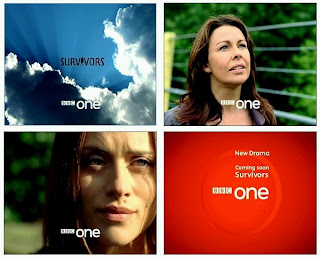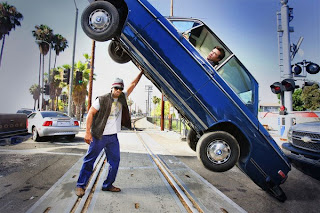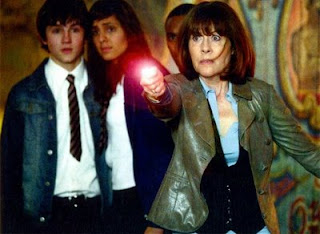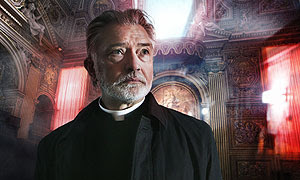
A couple of years ago, basking in the glory of his successful reinvention of Dr Who, Russell T Davies was asked which science-fiction classic he’d next like to resurrect. Russell wisely – and correctly – answered that there was nothing else he was interested in as he’d “done the best.” In passing, though, he did mention that, if pushed, he’d have a crack at reviving the 1975 Terry Nation drama Survivors, about life in the UK after a virulent pandemic has wiped out 99% of the world’s population. “Ah, if only…” I sighed at the time (that is, if only Russell or somebody would remake Survivors, not if only a virulent pandemic would wipe out 99% of the world’s population. Hmmm…saying that, though….) Survivors has long been one of the favourite TV shows; watching it back in 195, at the same time as I discovered John Wyndham’s astonishing ‘Day of the Triffids’ novel in the library of the polytechnic at which I’d just enrolled do take my A-levels (yes, yes, polytechnics….that’s how old I am, dear reader) instilled in me a fascination for post-apocalyptic stories which remains with me to this day (to the extent that I’m actually writing one of my own and, if I’m honest, have been writing it for so long that the world will actually have ended by the time I finish the damned thing).
Meanwhile, at the time of writing, we’re just over 24 hours away from the first of six brand new television episodes of Survivors, remade and reimagined for the 21st century courtesy of Adrian Hodges who, amongst other credits, has given us the agreeable ITV Saturday night adventure romp Primeval which launches its third series next year. So what can we expect from this new BBC series and what is it about the old series which made it so memorable to those of us who saw it at the time, what’s so special about its themes and its storylines and its characters?

The original series of Survivors (re-released in a big ol’ BBC DVD boxset next week) was first screened in 1975 at a time of great unrest in the UK. The series, arriving in the wake of a long winter of power-cuts, escalating unemployment, sky-rocketing cost of living, was created by writer Terry Nation (who invented the Daleks for Dr Who back in 1963 and who would go on to create the far cheesier Blake’s 7 for the BBC a couple of years later) who seemed to capture the popular pessimistic zeitgeist of the day when he took his own fascination with the idea of a civilisation with all the tools of technology at its disposal finding itself helpless when those tools are taken away and the ability to use them lost or forgotten, and fashioned it into a stark and bleak drama which took the human race to the edge of extinction and the human spirit to the limits of its own endurance. The first episode, ‘The Fourth Horseman’, remains a compelling and powerful piece of drama even now, over thirty years later and, frankly, tomorrow’s debut episode of the new series will have to pull out all the stops to even come close to the dramatic power of the original. In that first episode we meet a handful of characters who will go on to form the heart of the first series. Abby Grant (Carolyn Seymour) is a well-off young mum living an opulent lifestyle in a big country house while her husband David (Peter Bowles) is Something Big in the city. Their son Peter is a boarder at a public school miles away. There’s talk of a new flu bug laying people low; some are even dying. In London secretary Jenny Richards (Lucy Fleming) tries to find medical help for her sick flatmate. When the girl’s ex-boyfriend, a doctor at the local hospital, tells her candidly how bad the situation is – and how many people are dying with no reported survivors – Jenny is advised to leave London fast. At the same time grubby Welsh tramp Tom Price (Talfryn Thomas, TV’s go-to Welshman in the 1970s) is looking after his own interests and has wisely decided to put as much distance between himself and the rest of the human race. By the end of an episode full of quiet, creeping dread and a real sense of humanity slowing down – entirely off-camera – Abby’s husband and everyone in the village is dead and society has just ground to a halt. It’s a tour de force, economically-written, beautifully-played by its cast and sensitively- directed by Pennant Roberts. Watching it now – and I watch it frequently (although, oddly, I’ve not watched it since I became aware of the imminent new series because I really want to give it a chance) – you can’t help but be struck by the fact that it’s a product of its time. By modern standards it’s slow and stagey and much of it is shot on videotape at the BBC studios (ah, happy days…). But it’s still an extraordinary piece of work because of its subject matter and its slow pace works for it because it draws the viewer into the situation and into the lives of the characters. Survivors is often criticised because its stories are told from the perspective of rather well-off middle class people whose lives are a bit disrupted because of this infernal disease; no more big houses and nice cars, just grubbing about in the land with those smelly oiks – the working class generally being characterised as feckless tramps and no-gooders who just want to cheat and steal. But that’s just the way TV was back then and to criticise it now for now being politically-incorrect and full of really offensive yah stereotypes is a bit like criticising the Romans for being useless at finding their way around the Internet.

Series one moves on from this effective debut episode by introducing more characters, particularly surly Greg Preston (stony-faced Ian McCulloch) an engineer who returns home to find his wife dead and a new world in front of him. Eventually the core trio – Abby, Jenny, Greg – gravitate towards one another and Abby reluctantly assumes the mantle of ‘leader’ of the group. They fetch up at an impressive derelict country pile called The Grange (in reality the picturesque and long-since renovated Hampton Court near Leominster in Herefordshire, fact fans) and start to collect a disparate group of equally shell-shocked survivors about them as they begin to form a new community away from the cesspits of the cities. Series one is Survivors at its best. Terry Nation saw the show as an adventure series and the best scripts in the first series are his; exciting stories which expose the ugly underbelly of human nature as greed and starvation take control and the need to survive at all cost becomes more important than the mere fact of having survived in the first place. But the show wasn’t afraid to tackle extremely difficult moral issues; when Tom Price rapes and murders a young girl in the community and points the finger of suspicion at another member – a lad who would today be described as having ‘learning difficulties’ - the rest of the group have to decide what sort of justice they can dispense in a civilisation which no longer has any rule of law.
All throughout the first series runs the sub-plot (it’d be a story arc today) of Abby and her quest to find her missing son Peter. A visit to his school at the end of the first episode reveals to Abby that Peter, a teacher and some other boys fled the place before the worst of the disease hit (as well as providing both Abby and the audience with a handy lecture on the show’s themes and ethos from a deaf teacher who stayed behind at the school) and while she appears to busy herself with setting up the new community and providing some stability for the survivors, Abby never gives up hope that he son is alive, out there in the wild somewhere. Series one ends with Abby finding hope in the news that a boy who may be her son has been spotted and that her community is establishing trading links with others nearby. As the credits roll there’s some hope, some flickering flame of optimism that maybe the human race can survive even this catastrophe.

Behind the scenes on the series, though, all was not well. Terry Nation clashed vocally with series producer Terence Dudley who had an entirely different vision for both the show and its cast. Nation walked, Seymour was sacked (and remember this was a show made at a time when it was extremely rare for a woman to take a leading dominant role in a TV series) and Dudley recreated the series in its second year as a gentler, more measured piece with less emphasis on men with guns and more focus on the trials and tribulations of running a farm. The second series was more character and issue-led, with episodes exploring whether women can have the right to chose to be pregnant in an under-populated world, the place of faith in a world ripped apart by plague and how a new society deals with even the most unsavoury of outsiders at a time when every life is precious. New characters appeared too; with most of the show’s first series cast killed off by a fire which destroyed the Grange (a format requirement forced on the show by the unavailability of the Hampton Court location which was beginning its renovation even as series one was filming there) in came a slew of new faces as the survivors of the survivors – Greg, Jenny, Arthur the businessman(Michael Gover) and Paul (Chris Tranchell) the hippy agricultural whizz-kid – joined up with a community at Whitecross run by beardy Charles Vaughn (Denis Lill), a fanatical ‘let’s-repopulate-the-world’ character they’d encountered early in the first series. Part of the narrative through-line of the second series was the power struggle between Greg and Charles, two alpha males quietly circling one another and jostling for position as ‘leader’ of the growing community. This tension becomes even more evident once you’re aware that there were professional tensions between McCulloch and Lill too. But, aside from a thrilling sojourn to a diseased and deserted London in the two-parter ‘Lights of London’, series two was a soggy and slightly uninvolving series which ended with Greg journeying off in a hot air balloon to find some survivors in Norway.
The third and final series, screening in 1977, saw the programme at least attempting to return to its roots. With McCulloch refusing to commit to the entire third series due to his dissatisfaction with the storylines for the second series (he wrote and appeared in only a couple of stories for the third year) the show took to the road again, moving away from the comfy security of the farm and sending those characters it brought back for the third year off on quests across the country , firstly to try and unify the disconnected settlements, then to try and find Greg, legendarily back from Norway and travelling the country as some sort of unofficial Messiah-figure and finally, in an unfortunate turn of events in the tail end of the series, a narratively ill-advised quest to restore electricity to the country. Series three is a grimier, tougher series than the second and in ‘Mad Dog’, where Charles, the only regular cast member to appear, encounters a man with rabies and then goes on the run from a gang who want to kill him in case he’s diseased, presents perhaps the finest, most exciting episode of the entire series. But by the time the last of the twelve season three episodes rumbles along, the show has moved so far from Terry Nation’s vision – the gang have discovered that there have been thousands of survivors in Scotland all along – that the dramatic impact of the whole idea has been lost. In the last episode, ‘Power’,a hydro-electric plant is reactivated and the lights come back on. There’s very much the sense here that the story’s told, there’s nowhere else to go.
The 1970s Survivors series, despite its faults, its longeurs, its implausibilities, remains a fascinating and disturbing piece of TV. The pace and style of its storytelling may take a bit of getting used to by an audience more attuned to contemporary story-telling styles but the central conceit remains as strong and as compelling now as it did then. With its evocative theme tune by Anthony Isaacs and possibly the most striking title sequence in TV history – a masked scientist drops a flask, a pool of red liquid (blood?) drenches the screen, a man in an airport is taken ill, a passport is franked with wordwide destinations – Survivors is a show which seared itself into the psyche of its audience and stayed with them long after its final episode had faded from the screen.
The post-apocalypse story has always held a huge and morbid fascination, especially in Britain where writers like Wyndham, Sam Youd (aka John Christopher) and Simon Clarke have destroyed the world on numerous occasions. Nation’s idea – so simple and yet so strong – was, in hindsight, always going to be one that some bright TV spark would want to revisit in the 21st century where good ideas on TV are few and far between…

Which brings us, neatly enough, to tomorrow night’s debut of the new series. Early word is good and those fortunate enough to have seen previews have given an enthusiastic thumbs-up; reality TV-obsessed newspaper types have been more ambivalent. Possibly it required more of them than watching zombie audiences clapping along to the music and then screeching with excitement when some faded micro-celeb is ‘voted off’ by a general public with more money than sense. Ahem. Anyway, inspired more by Nation’s novelisation of the series (which itself moved in different directions to the TV episodes) than the original episodes, the main characters have been revisited. Abby Grant is now played by Julie Graham (who is, despite the evidence of the shockingly-appalling Bonekickers earlier this year, a very fine actress) and Patterson Joseph (the man who, rumour has it, would be the next Dr Who) is the new Greg and the Jenny Richards of the original has become teacher Jenny Collins (Dr Who/Torchwood star Freema Agyeman) and, in the most significant reboot of all, stinky Tom Price has been reinvented as a charismatic psychopathic escaped convict played by Max Beesley. The first few episodes appear to revisit themes and stories of the first series – in a new version of series one’s ‘Garland’s War’ Abby meets Jimmy Garland (now played by Sarah Jane Adventures’ Joseph Milsom – Maria’s Dad!) whose country home has been taken over by gun-toting thugs and there’s even a conspiracy theory storyline with government survivors skulking about in an underground bunker.

I’m optimistic and pessimistic. I want to approach the series and enjoy it on its own merits; I adore the original show so much it’ll be hard – maybe impossible – to watch it without comparing and contrasting with the original. But I’ll try. It looks good; the trailers running on BBC1 are concentrating on the human drama of the situation rather than the drama of the stories so could be said to look a bit low-key and under-whelming. But the show’s got a decent pedigree, it’s clearly a quality production and let’s remember that, five years ago, a show like this would never have made its way onto British TV because nervy executives would have argued that there’s no appetite out there for stuff like this. But as well know, our perceptions of what TV can and can’t do changed radically in March 2005 when a certain Police Box reappeared on our screens and opened everyone’s eyes to a world of TV drama beyond the four walls of the hospital and the police station. My concern for Survivors in purely in the fact that it’s been scheduled directly opposite the inexplicably-popular ITV mind-rot I’m A Celebrity which has already seen off all BBC opposition this week – including the excellent Apparitions which has been pretty much annihilated in the latest ratings. It would be a shame – no, make that a tragedy – if Survivors, an exciting, intelligent, thought-provoking drama, is flattened in the ratings by Esther Rantzen and some bloke out of EastEnders eating a kangaroo’s knackers live on ITV.
But then..it’s a funny old world, innit?
World of Stuff will be reviewing the first episodes of Survivors...any day now!










